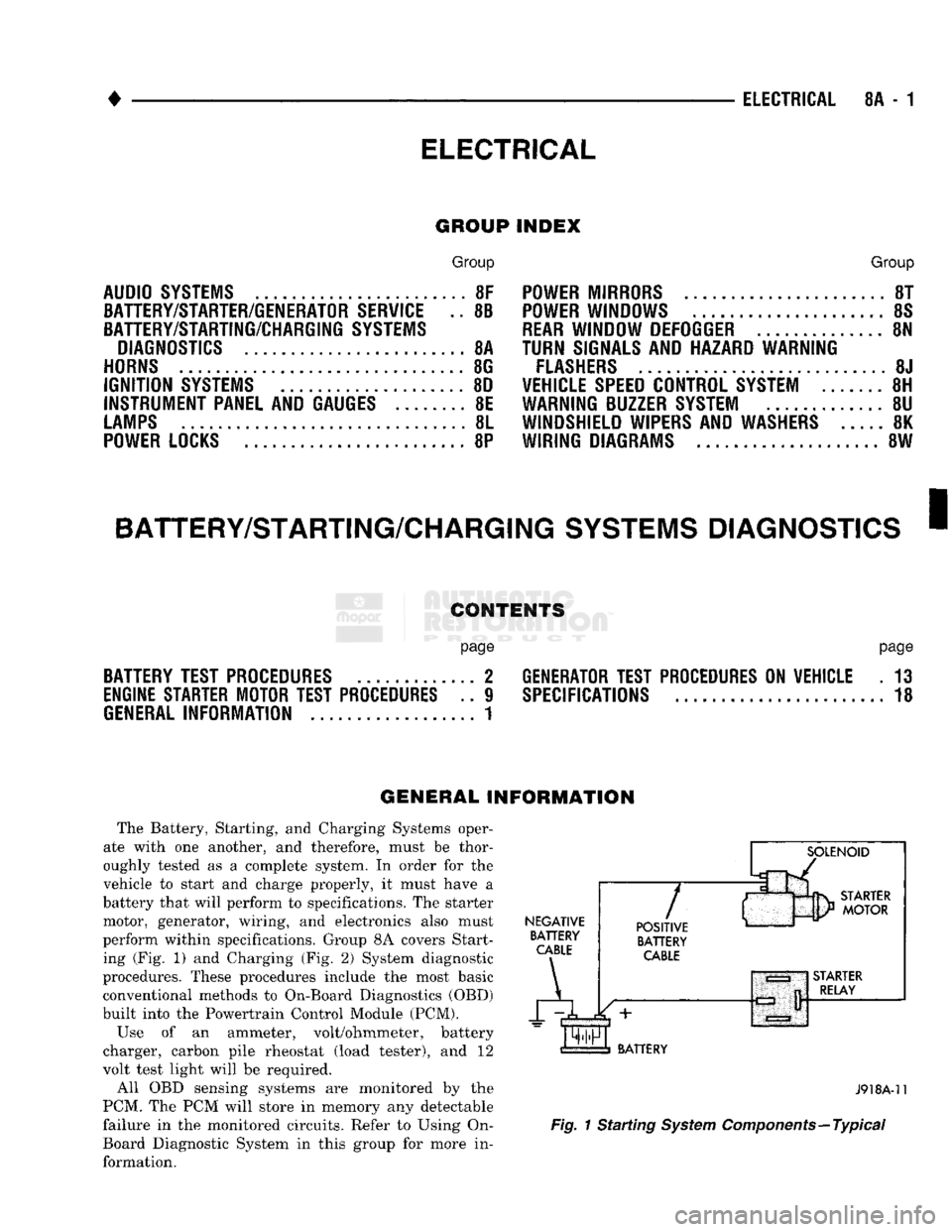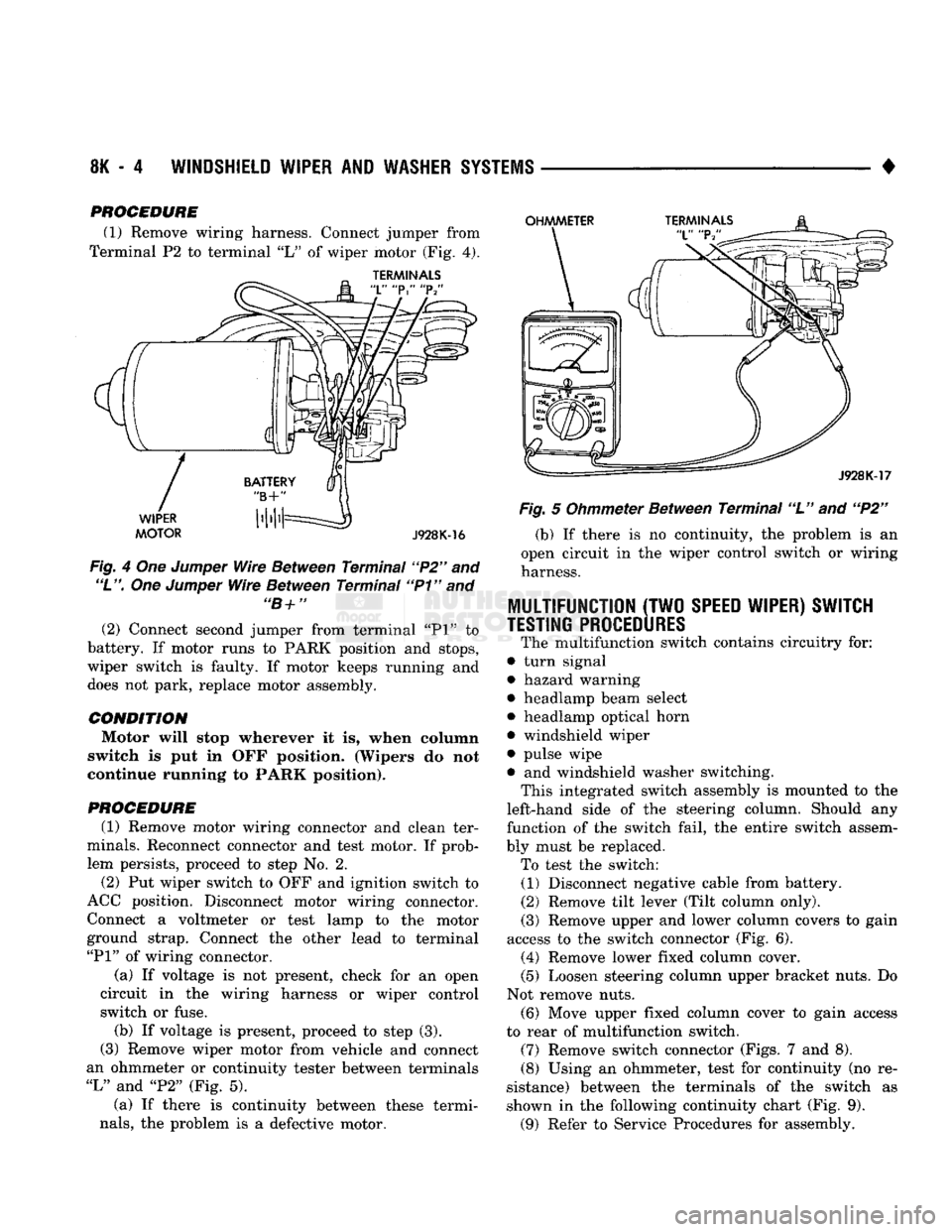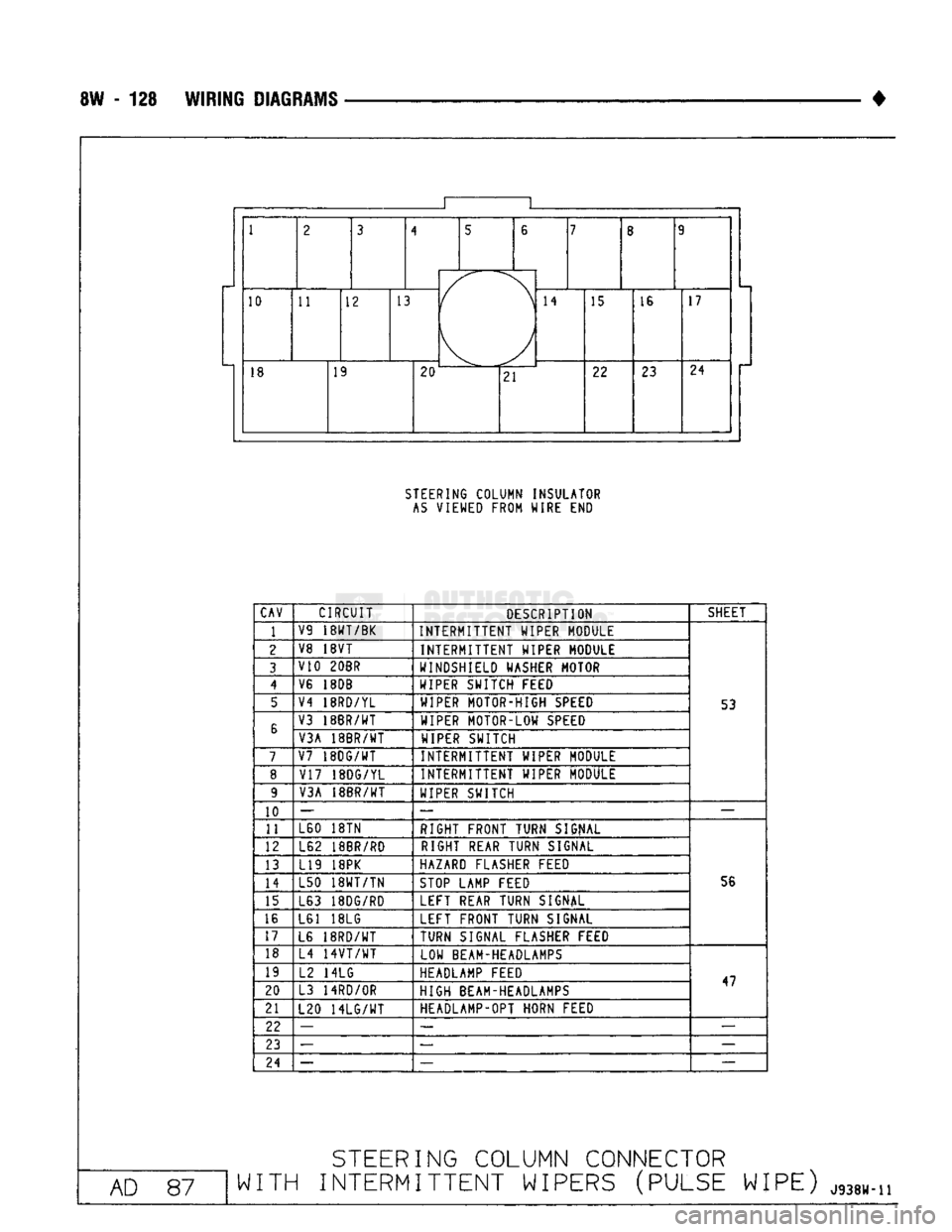1993 DODGE TRUCK wipers
[x] Cancel search: wipersPage 322 of 1502

•
ELECTRICAL
ELECTRICAL
8A - 1
Group
AUDIO
SYSTEMS
8F
BATTERY/STARTER/GENERATOR
SERVICE
.. 8B
BATTERY/STARTING/CHARGING
SYSTEMS
DIAGNOSTICS
8A
HORNS
8G
IGNITION
SYSTEMS
8D
INSTRUMENT PANEL AND
GAUGES
8E
LAMPS
8L
POWER
LOCKS
8P
INDEX
Group
POWER
MIRRORS
8T
POWER
WINDOWS 8S
REAR
WINDOW DEFOGGER 8N
TURN
SIGNALS
AND HAZARD WARNING
FLASHERS
8J
VEHICLE
SPEED
CONTROL SYSTEM 8H WARNING BUZZER SYSTEM 8U
WINDSHIELD WIPERS AND
WASHERS
8K
WIRING DIAGRAMS 8W
BATTERY/STARTING/CHARGING SYSTEMS DIAGNOSTICS
CONTENTS
page
page
BATTERY TEST
PROCEDURES
2 GENERATOR TEST
PROCEDURES
ON VEHICLE . 13
ENGINE
STARTER MOTOR TEST
PROCEDURES
..9 SPECIFICATIONS 18
GENERAL
INFORMATION 1
GENERAL INFORMATION
The Battery, Starting, and Charging Systems oper
ate with one another, and therefore, must be thor
oughly tested as a complete system. In order for the
vehicle to start and charge properly, it must have a
battery that will perform to specifications. The starter
motor, generator, wiring, and electronics also must
perform within specifications. Group 8A covers Start ing (Fig. 1) and Charging (Fig. 2) System diagnostic
procedures. These procedures include the most basic
conventional methods to On-Board Diagnostics (OBD)
built into the Powertrain Control Module (PCM).
Use of an ammeter, volt/ohmmeter, battery
charger, carbon pile rheostat (load tester), and 12
volt test light will be required.
All OBD sensing systems are monitored by the
PCM. The PCM will store in memory any detectable
failure in the monitored circuits. Refer to Using On-
Board Diagnostic System in this group for more in formation.
NEGATIVE
BATTERY
CABLE
A
7
POSITIVE
BATTERY
CABLE
BATTERY
J918A-11
Fig.
1 Starting
System
Components—Typical
Page 432 of 1502

•
WINDSHIELD WIPER
AND
WASHER SYSTEMS
8K - 1
WINDSHIELD WIPER
AND
WASHER SYSTEMS
CONTENTS
page
INTERMITTENT WINDSHIELD WIPER FUNCTION AND SWITCH TESTING PROCEDURES
6
TWO SPEED WINDSHIELD WIPER MOTOR
AND
SWITCH TESTING PROCEDURES
1
GENERAL
INFORMATION
The windshield wipers
can be
operated with
the
windshield wiper switch only when
the
ignition switch
is in the
ACCESSORY
or RUN
position.
A
fuse located
in the
fuse block protects
the
circuitry
of
the wiper system
and the
vehicle. The same motor
is
used
for
standard
and
intermit
tent wipe systems. The wiper motor
has
permanent magnet fields.
The
speeds
are
determined
by
current flow
to the
appro
priate
set of
brushes. The intermittent wipe system
in
addition
to low
page
WINDSHIELD WASHERS .. 10
WINDSHIELD WIPER SYSTEM SERVICE PROCEDURES 7
and high speed,
has a
delay mode.
The
delay mode
has
a
range
of 2 to 15
seconds. This
is
accomplished
by
a
variable resistor
in the
wiper switch
and is
con trolled electrically
by a
control module.
The wiper system completes
the
wipe cycle when
the switch
is
turned
OFF. The
blades park
in the
lowest portion
of the
wipe pattern.
Depressing
the
washer knob while
the
system
is in
the
OFF
position, • turns
the
wiper motor
on
• allows
the
motor
to
operate through
3-4
wipe
cy
cles
and
then turn
OFF.
TWO SPEED WINDSHIELD WIPER MOTOR
AND
SWITCH TESTING PROCEDURES INDEX
page
Multifunction
(Two
Speed
Wiper) Switch Testing
Procedures
4
TWO SPEED WIPER MOTOR TESTING PROCEDURES
The following
is a
list
of
general wiper motor sys
tem problems.
It
contains
the
tests that
are to be
per
formed
to
locate
the
faulty part,
and the
corrective action
to be
taken.
The
same motor
is
used
for
stan
dard
and
optional systems.
If the
malfunction
in
volves only
the
Delay mode, switch,
or
wiring, refer
to
the
Intermittent Windshield Wiper Motor
and
Switch Service Procedures.
CONDITION
Motor will
not run in any
switch position.
PROCEDURE
(1) Check
for a
blown fuse
in the
fuse block.
(a)
If
fuse
is
good, proceed
to
step
No. 2.
(b)
If
fuse
is
defective, replace
and
check motor
operation
in all
switch positions.
(c)
If
motor
is
still inoperative
and the
fuse does
not blow, proceed
to
step
No. 2.
page
Two Speed
Wiper Motor Testing Procedures
1
(d)
If
replacement fuse blows, proceed
to
step
No.
5.
(2) Place switch
in low
speed position.
(3) Listen
to
motor.
If you
cannot hear
it
running,
proceed
to
step
No. 4. If you
hear
it
running, check
motor output shaft.
If
output shaft
is not
turning,
re
place motor assembly.
If it is
turning, crank
arm or
drive link
is not
properly connected. Replace worn
parts and/or properly connect drive link
to the
motor output shaft.
(4) Connect
a
voltmeter between motor terminal
"L"
and
ground strap
(Fig. 1). If
there
is no
voltage
or very little voltage (less than
one
volt) present,
move negative test lead from
the
ground strap
to
bat
tery negative terminal.
(a)
If an
increase
in
voltage
is
noticed,
the
prob
lem
is a bad
ground circuit. Make sure
the
motor
mounting
is
free
of
paint
and
that nuts
or
bolts
are
tight.
Page 435 of 1502

8K - 4
WINDSHIELD WIPER
AND
WASHER
SYSTEMS
•
PROCEDURE (1) Remove wiring harness. Connect jumper from
Terminal P2 to terminal "L" of wiper motor (Fig, 4).
TERMINALS
Fig. 4 Om Jumper Wire Between Terminal "P2" and
"L".
One Jumper Wire Between Terminal "P1" and "B+" (2) Connect second jumper from terminal "PI" to
battery. If motor runs to PARK position and stops,
wiper switch is faulty. If motor keeps running and
does not park, replace motor assembly.
CONDITION Motor will stop wherever it is, when column
switch is put in OFF position. (Wipers do not
continue running to PARK position).
PROCEDURE
(1) Remove motor wiring connector and clean ter
minals. Reconnect connector and test motor. If prob lem persists, proceed to step No. 2.
(2) Put wiper switch to OFF and ignition switch to
ACC position. Disconnect motor wiring connector. Connect a voltmeter or test lamp to the motor
ground strap. Connect the other lead to terminal
"PI"
of wiring connector.
(a) If voltage is not present, check for an open
circuit in the wiring harness or wiper control
switch or fuse. (b) If voltage is present, proceed to step (3).
(3) Remove wiper motor from vehicle and connect
an ohmmeter or continuity tester between terminals
"L"
and "P2" (Fig. 5).
(a) If there is continuity between these termi
nals,
the problem is a defective motor. Fig. 5 Ohmmeter Between Terminal "L" and "P2"
(b) If there is no continuity, the problem is an
open circuit in the wiper control switch or wiring
harness.
MULTIFUNCTION
(TWO
SPEED WIPER) SWITCH
TESTING PROCEDURES
The multifunction switch contains circuitry for:
• turn signal
• hazard warning
• headlamp beam select
• headlamp optical horn
• windshield wiper
• pulse wipe
• and windshield washer switching. This integrated switch assembly is mounted to the
left-hand side of the steering column. Should any
function of the switch fail, the entire switch assem
bly must be replaced. To test the switch: (1) Disconnect negative cable from battery.
(2) Remove tilt lever (Tilt column only).
(3)
Remove upper and lower column covers to gain
access to the switch connector (Fig. 6). (4) Remove lower fixed column cover.
(5) Loosen steering column upper bracket nuts. Do
Not remove nuts.
(6)
Move upper fixed column cover to gain access
to rear of multifunction switch.
(7)
Remove switch connector (Figs. 7 and 8).
(8)
Using an ohmmeter, test for continuity (no re
sistance) between the terminals of the switch as
shown in the following continuity chart (Fig. 9).
(9)
Refer to Service Procedures for assembly.
Page 437 of 1502

8K
- 6
WINDSHIELD WIPER
AND
WASHER SYSTEMS
• INTERMITTENT WINDSHIELD WIPER FUNCTION
AND
SWITCH TESTING
PROCEDURES
INTERMITTENT
WIPER
FUNCTION
TESTING
PROCEDURES
The intermittent wipe and standard two speed mo
tors are identical. Refer to previous sections for diag
nosis of system problems which do not involve the
DELAY function. If problem occurs only in the DE LAY mode, the following tests are to be performed.
These tests involve disconnecting the intermittent wipe control unit which can be found on the steering column support bracket (Fig. 2).
CONDITION Excessive delay (more than 30 seconds) or in
adequate variation in delay.
PROCEDURE Variations in delay should be as follows: (1) Minimum delay (delay control to extreme coun
terclockwise position before first detent) 1/2 to 2 sec
onds.
(2) Maximum delay (delay control to extreme
clockwise position before off detent) 10 to 30 seconds.
(3) If there is excessive delay or no variations in
delay proceed to intermittent wipe switch test.
CONDITION In DELAY mode wipers run continually when
wash is operated but do not provide an extra
wipe when the wash control is released.
PROCEDURE Replace the control unit.
CONDITION ' Wipers start erratically during DELAY mode.
PROCEDURE (1) Verify that the ground connection at the in
strument panel is making good connection (free from
paint) and is tight.
(2) Verify that the motor ground strap is making
good contact and that the motor mounting bolts are
tight.
(3) Verify that the wiring ground connections for
the intermittent wipe control unit and the wiper switch are tight.
(4) If condition is not corrected, replace control
unit.
MULTIFUNCTION (INTERMITTENT WIPER) SWITCH
TESTING
PROCEDURES
Refer to Multifunction (Two Speed Wiper) Switch
Testing Procedures using the following continuity chart.
i
24 23 22
21 20 19
17 16 15 14
/V~\M3
12 11 10 9 8
7
6 V5^4 3
.
2 1
EZJ
CZ3 CZ3 C3 Jr
L
JT
MULTIFUNCTION
SWITCH
PINS
SWITCH
POSITION
CONTINUITY
BETWEEN
OFF
PIN
6 AND PIN 7
DELAY
PIN 8 AND PIN 9
PIN 2 AND PIN 4
PIN
1
AND PIN 2
PIN
1
AND PIN 4
LOW PIN 4 AND PIN 6
HIGH
PIN 4 AND PIN 5
WASH
PIN 3 AND PIN 4
*
RESISTANCE
AT
AAAXIMUM
DELAY
POSITION
SHOULD
BE
BETWEEN
270,000
OHMS
AND
330,000
OHMS.
•RESISTANCE
AT
MINIMUM
DELAY
POSITION
SHOULD
BE
ZERO
WITH
OHMMETER
SET ON
HIGH
OHM
SCALE.
918J-4
Fig.
11ntermittent
Wipe
Switch
Continuity Chart
INTERMITTENT WIPE MODULE LOCATION
The intermittent wipe module is located to the
right of the steering column on the back side of the instrument panel (Fig. 2).
BUZZER
MODULE
INTERMITTENT
WIPE
MODULE
Fig.
2
Intermittent
Wipe
Module
Location
Page 477 of 1502

8W
- 2
WIRING
DIAGRAMS
•
WIRE CODE
IDENTIFICATION
Each wire shown in the diagrams contains a code
(Fig. 3) which identifies the main circuit, part of the
main circuit, gauge of wire, and color. The color is shown as a two letter code which can be identified by
referring to the Wire Color Code Chart (Fig. 4). If
the wire has a tracer and it is a standard color an asterisk will follow the main wire color. If the tracer
is non-standard the main wire color will have a slash (/) after it followed by the tracer color. 18
LB/YL*
COLOR
OF
WIRE
(Light
Blue
with
Yellow
Tracer)
.
GAUGE
OF
WIRE
(18
Gauge)
PART
OF
AAAIN CIRCUIT
(Varies
Depending
on
Equipment)
AAAIN CIRCUIT
IDENTIFICATION
918W-16
Fig.
3
Wire
Color
Code
Identification
CIRCUIT IDENTIFICATION
All circuits in the diagrams use an alpha/numeric
code to identify the, wire and its function. To identify
which circuit code applies to a system, refer to the
Circuit Identification Code Chart. This chart shows
the main circuits only and does not show the second ary codes that may apply to some models.
COLOR
CODE COLOR
STANDARD
TRACER
COLOR COLOR
CODE
COLOR
STANDARD
TRACER
CODE
BL BLUE WT
OR ORANGE
BK
BK
BLACK
WT PK
PINK
BK
OR WT
BR
BROWN
WT RD
RED WT
DB DARK
BLUE WT
TN
TAN WT
DG DARK
GREEN WT
VT
VIOLET
WT
GY GRAY
BK
WT
WHITE
BK
LB
LIGHT
BLUE
BK
YL YELLOW
BK
LG
LIGHT
GREEN
BK
*
WITH
TRACER
918W-136
Fig.
4
Wire
Color
Code
Chart
LOCATING
A
SYSTEM
OR
COMPONENT
To locate a system or component in the diagrams,
refer to the alphabetical index at the front of the di agrams. Determine the diagram sheet number. Sheet
numbers are located at the lower right or left hand
corner of each sheet. Page numbers at the top of
the page do not apply to diagram sheets. The diagram index identifies the main system and
all components that relate to that system. There are
also sections of the index that identify specific com
ponents only (for example modules, lamps, etc.). Re-
MAIN
CIRCUIT IDENTIFICATION
CIRCUIT
DESCRIPTION
CIRCUIT
DESCRIPTION
A
Battery
Feed: Fused and Unfused
P
Power
Assist
System:
Locks,
Mirrors
B
ABS
System Q Power
Assist
System: Windows
C
Air Conditioning System
R
Airbag System
D
CCD
(+),
CCD
(-)
S
Air Suspension, Automatic Load Leveling
E
Interior
Lamp
Illumination
T Electronic Automatic Transaxle
F
Battery
Feed: Fused and Unfused
V
Windshield Wipers and Washers,
G
Sensors,
Sending Units, Switches Vehicle Speed Control System
K
Powertrain
Central
Module W Power
Assist
System: Windows
L
Exterior
Lighting, Stop Lamp Switch
X
Horn, Radio, Radio Speakers, Power Locks
M
Interior
Lamps
Z
Ground Circuits: Includes power and signal
Interior
Lamps
grounds
for PCM
938W-17
Page 482 of 1502

CAVITY
FUSE/
COLOR ITEMS FUSED
CAVITY
FUSE/
COLOR ITEMS FUSED
10
11
12
13 2 AMP
GY VEHICLE SPEED CONTROL
5 AMP TN
GAUGES,
BRAKE WARNING LAMP, SEAT BELT WARNING
LAMP, BUZZER, LOW OIL LAMP, CHECK ENGINE LAMP,
ANTI-LOCK LAMP, TAILGATE OPEN LAMP, 4WD LAMP, O/D MODULE, LOW FUEL LAMP,
WAIT
TO START LAMP
WATER-IN-FUEL LAMP 14
3 AMP
VT
20 AMP YL BACK-UP LAMP, HEATED REAR WINDOW
15 10 AMP
RD
ILLUMINATION
LAMPS, A/C HEATER LAMP, ASH
RECEIVER LAMP, RADIO LAMP, TRANSMISSION
OVERDRIVE SWITCH LAMP, TACHOMETER LAMP, HEATED REAR WINDOW SWITCH LAMP.
RADIO AND CLOCK MEMORY, POWER MIRRORS, GLOVE BOX LAMP, DOME LAMP, READING LAMP, MAP LAMP,
CARGO LAMP,
IGNITION
SWITCH LAMP, UNDERHOOD LAMP
20 AMP YL FUSE CAVITY #14,
TAIL
LAMPS, PARKING LAMPS, SIDE
AAARKER
LAMPS, LICENSE LAMPS, FRONT AND REAR CLEARANCE LAMPS, RADIO INTENSITY, HORNS
20 AMP YL STOP LAMPS, KEY-IN & HEADLAMP ON BUZZER, RWAL
MODULE 30 AMP
CIRCUIT
BREAKER
TURN
SIGNAL
FLASHER 20 AMP
YL POWER DOOR LOCKS
15 AMP
BL
CIGAR LIGHTER
10 AMP RD RADIO AND CLOCK
20 AMP YL
TURN
SIGNALS, TACHOMETER PROVISION,
RWAL MODULE
20 AMP YL WINDSHIELD WIPERS
30 AMP LG A/C - HEATER BLOWER MOTOR
30 AMP
C/BRKR
POWER WINDOWS
20 AMP YL HAZARD FLASHER
AMPS
FUSE
COLOR
2 GY GRAY
3 VT
VIOLET
5 TN
TAN
10 RD
RED
15
BL
BLUE
20 YL YELLOW
30 LG
LIGHT
GREEN HAZARD
FLASHER
J938W-94
Fig. 12 Fuse Block and
Relay
Bank
Page 603 of 1502

8W - 128 WIRING
DIAGRAMS
• 10
11 12
13
14
15 16 17
18 19
20
21 22
23 24
STEERING
COLUMN INSULATOR
AS
VIEWED FROM WIRE END
CAV
CIRCUIT
DESCRIPTION SHEET
1
V9
18WT/BK
INTERMITTENT WIPER MODULE
2 V8 18VT
INTERMITTENT WIPER MODULE
3 V10 20BR
WINDSHIELD WASHER MOTOR
4 V6 18DB
WIPER SWITCH FEED
5 V4 18RD/YL
WIPER MOTOR-HIGH SPEED
53
6 V3 18BR/WT
WIPER MOTOR-LOW SPEED
6
V3A 18BR/WT WIPER SWITCH
7 V7
18DG/WT
INTERMITTENT WIPER MODULE
8
V17 18DG/YL INTERMITTENT WIPER MODULE
9 V3A 18BR/WT
WIPER SWITCH
10 —
— —
11 L60 18TN
RIGHT FRONT TURN SIGNAL
12 L62 18BR/RD RIGHT REAR TURN SIGNAL
13 L19 18PK HAZARD FLASHER FEED
14 L50
18WT/TN
STOP LAMP FEED 56
15 L63 18DG/RD LEFT REAR TURN SIGNAL
16 L61 18LG LEFT FRONT TURN SIGNAL
17 L6
18RD/WT
TURN SIGNAL FLASHER FEED
18 L4
14VT/WT
LOW BEAM-HEADLAMPS
19 L2 14LG HEADLAMP FEED
47
20 L3
14RD/0R
HIGH BEAM-HEADLAMPS 47
21 L20
14LG/WT
HEADLAMP-OPT HORN FEED
22 —
— —
23 —
—
24 — —-
—
AD
87
STEERING
COLUMN CONNECTOR
WITH
INTERMITTENT WIPERS (PULSE WIPE)
J938W.n
Page 604 of 1502

•
WIRING DIAGRAMS 8W - 129 1
1
2 3
4 5
6
7
8 9
1
2 3
(
\ ) 7
8 9
10 11 12 13
(
\ ) 14
15 16 17
18 19
20 ^-— -
21 22
23 24
STEERING COLUMN INSULATOR
AS
VIEWED FROM WIRE END
CAV CIRCUIT
DESCRIPTION SHEET
1
V3
18BR/WT
WIPER MOTOR-LOW SPEED
55
2
V5 18DG
WIPER-PARK
55
3 V10
20BR
WASHER MOTOR 55
4 V6 18DB
WIPER-IGNITION FEED 55
5 V4
18RD/YL
WIPER MOTOR-HIGH SPEED 55
6 —
— —
7 —
— —
8 —
— —
9 —
— —
10 —
— —
11 L60 18TN
RIGHT FRONT TURN SIGNAL
56
12
L62 18BR/RD
RIGHT REAR TURN SIGNAL
56
13
L19 18PK
HAZARD FLASHER FEED
56
14 L50
18WT/TN
STOP LAMP FEED 56
15 L63 18DG/RD
LEFT REAR TURN SIGNAL 56
16 L61 18LG
LEFT FRONT TURN SIGNAL 56
17 L6
18RD/WT
TURN SIGNAL-FLASHER FEED 56
18 L4
14VT/WT
LOW BEAM-HEADLAMPS
47
19
L2 14LG HEADLAMP FEED
47
20 L3 14RD/OR
HIGH BEAM-HEADLAMPS 47
21 L20
14LG/WT
HEADLAMP-OPT HORN FEED 47
22 —
— —
23 —
— —
24 —
—
—
J938H-11
STEERING
COLUMN CONNECTOR
WITH 2
SPEED
WIPERS
AD 88